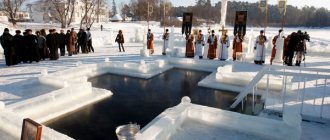One of the teachings of Christ is the doctrine of baptisms. As we have already said, whenever people add something of their own that they think is necessary into the perfect Word of God, there is a deviation from the truth. Divisions in the church, disputes, and strife begin. It is not for nothing that it is said that we should not deviate from SIMPLICITY IN CHRIST. The gospel should be understandable even to children. Water baptism is another way to either do the will of God or lie to the truth . Let's figure it out.
What is baptism in water for?
Any action that the Lord said to do has a special meaning. Even if someone doesn’t fully understand, you just need to trust God. When we talked about John's baptism, we saw that this action was preceded by the word of God to the minister. This was so important that even Jesus Himself was baptized to fulfill all righteousness .
Jesus' Commission
The word for “teach” in Greek is “to make a disciple.” So this great message for preaching the gospel must be accompanied by water baptism IN THE NAME...
Let's stop for a second. There is disagreement among Bible teachers about HOW TO BAPTIZE CORRECTLY. Some, using this passage from Matthew, say that in the name of the Father, Son and Holy Spirit. Others say that true baptism is in the name of Jesus.
Baptize in the name of the Father and the Son and the Holy Spirit
The word baptize means “to immerse.” So during water baptism Jesus said to immerse in the name!!! Look very carefully. NOT IN NAMES. In the name. One name. Let's read this name again. Father and Son and Holy Spirit. It may sound quite strange. But let's remember that the name in the Bible always corresponded to the person who bore it. The name showed the qualities of a person.
Abraham is the father of the multitude, Jedidiah (Solomon) is the beloved of God, Eve is the giver of life, Jacob is the deceiver, Israel is God who fights...
Likewise here, the name symbolizes the One who possesses it. Our God, who is both Father and Son and Spirit. That is, a person is baptized in the name of God, which symbolizes the Father, the Son and the Spirit.
Be baptized in the name of Jesus Christ
We see that Jesus' Word of baptism in the name of the Father, Son and Holy Spirit was received by the Apostles and carried out as baptism in the name of Jesus. Is there a difference? What does the name of Jesus mean? The Hebrew translation is “The Lord is salvation.” What's the conclusion? We immerse ourselves in the Lord who is salvation. Based on the fact that Jesus is God, the Word, and our salvation, which is given to us by God, I see no difference in the wording itself - to be baptized in the name of Jesus, in the name of God, in the name “Father, Word and Spirit.”
The Apostle Paul reproaches the people in Corinth because they began to be called by the names of the one who baptized them.
Notice that Paul shows the importance of the CROSS OF CHRIST as opposed to the names. When we receive water baptism, we are immersed in water, which symbolizes our death to ourselves and this world. And we come out of the water already risen with Christ. In God, having new life. These are symbols. And we must treat them this way, without giving them what is not there, SO AS NOT TO ABOLISH THE CROSS OF CHRIST .
^ Teachings of the Eastern Orthodox Church on baptism, de-baptism, re-baptism and baptism
In 2000, Patriarch Alexy II, in his address to the clergy of the Russian Orthodox Church, wrote about the inadmissibility of pouring baptism and called on everyone to return to the original Orthodox method of baptism, performed in three immersions. What prompted our patriarch to raise this long-standing issue and why pouring a small amount of water during baptism is unacceptable?! Let us turn to the history of the Church and familiarize ourselves with its rules and canons in order to understand this issue.
So what do St. tell us? fathers about pouring baptism and is it really as harmless as it might seem at first glance?
The death of Jesus Christ, as explained in the Greek Helmsman, was the only necessary means of salvation for the human race: this is an indisputable dogma of the Orthodox faith. Without it, it was not possible for man to be reconciled with God, which is why the apostle says: Having been defeated, let us be reconciled to God through the death of His Son. The image of the death of Christ is expressed in every church rite, but primarily it acts in the sacrament of baptism through three immersions performed in it, because in all others the image of the Lord’s death occurs outside a person, and in baptism the person himself depicts it on himself, that is, the baptized person himself figuratively dies and is buried by Christ in the waters of baptism.
We are baptized into Christ,” says the apostle; “we are baptized into His death.” Therefore, in order for there to be in us the likeness of the death and three-day burial of Christ, there must be three immersions in baptism. This dogma can in no way be expressed in pouring baptism. The Trinity can be depicted in it, but the burial and resurrection of Christ is not thought of in the pouring.
Surely there will be people who will say that all these are ritual trifles and you shouldn’t focus your attention on this, the main thing is that the person being baptized corrects his life according to the commandments of Christ, and everything else is unimportant. This thought, at first glance, may seem so bright and correct that it will not be immediately possible to detect dark spots in it. In order to understand how important immersion during baptism is, let us turn to the teacher of the Church of Christ, Saint Cyril of Jerusalem.
In his mystical teaching, he writes: Jesus sanctified baptism by being baptized Himself. If the Son of God was baptized, then what pious person can despise baptism? He was not baptized in order to receive forgiveness of sins (for He was sinless), but being sinless, He was baptized in order to bestow Divine grace and glory on those who were baptized. For just as, following the example of children who have flesh and blood, He Himself accepted the same, so that we, having become participants with Him in His incarnate appearance, together would become participants in His Divine grace: so Jesus was baptized in order that through this we having again become partners with Him, they could receive glory along with salvation.
You descend onto the water with your sins: but the Grace-filled calling that has imprinted your soul will no longer allow you to be swallowed up by the terrible dragon. Having descended dead through sins, you ascend quickened by righteousness. For if you have been made conformed to the likeness of death (Rom.
6:5) Savior, then you will be worthy of resurrection. Because, just as Jesus, having taken upon Himself the sins of the universe, died in order to put to death sin, to resurrect you with righteousness: so you too, having descended onto the water, and in some way being buried in it, like He was in a stone tomb, rise again to walk in the newness of life. (Rom.6:4). Then, when you are rewarded with grace, then He will give you the strength to fight the enemy forces... Jesus Christ was (and is - author's note) the Son of God. But it was not before His baptism that He began to preach the Gospel. If the Lord Himself observed the order of time; Will we, slaves, begin to do anything without following order? (...) Approach baptism not as to simple water, but as to spiritual grace, given with water.
For just as what is sacrificed, simple in nature, is profaned through the invocation of idols, so on the contrary, simple water, having received power from the invocation of the Holy Spirit and Christ and the Father, becomes holy. Since a person consists of two parts, soul and body, the purification is twofold: incorporeal for the incorporeal, and corporeal for the body. Water cleanses the body, and the Spirit seals the soul, so that we can approach God with a heart sprinkled and a body washed with clean water. So, when you go down to the water; then do not imagine simple water, but expect salvation from the action of the Holy Spirit.
For without both, it is impossible for you to achieve perfection. It is not I who say this, but the Lord Jesus Christ, who has authority in this matter; He says: unless someone is born again and adds the words: by water and by the Spirit, he cannot enter into the Kingdom of God (John 3:3-5). Neither one who is baptized with water, but is not awarded the Spirit, has perfect grace; no one who, even if he was good in deeds, but did not receive the seal with water, will enter the Kingdom of Heaven. The word is bold, but not mine; for so Jesus determined.
And here is the proof in the Divine Scripture: Cornelius was a righteous man, worthy of the vision of the angel; his prayers and alms represented a beautiful pillar in heaven before God. Peter came and the Spirit was poured out on the believers, and they began to speak in other tongues and prophesy; however, Scripture says that even after this spiritual grace, Peter commanded them to be baptized in the name of Jesus Christ, so that after the rebirth of the soul by faith, grace and body would receive through water. If anyone wants to know why he gives grace through water, and not through another element, he will find the solution to this in the Divine Scripture. Water is something special and the best of the four visible elements of the world.
Heaven is the home of Angels, but heaven is made of water. The earth is the habitation of men, but the earth is made of water. And before all of the six-day dispensation of creatures, the Spirit of God hovered over the waters. The beginning of the world is water; and the beginning of the Gospel is Jordan.
The liberation of Israel from Pharaoh was accomplished through the sea, and the liberation of the world from sins is accomplished through washing with water under the action of the Word of God. Wherever God enters into a covenant with someone, there is water. A covenant was made with Noah after the flood; a covenant was made with Israel at Mount Sinai; but it is also concluded through water, scarlet wave and hyssop. Elijah ascends, but even here he is not without water.
For first it passes through the Jordan, then it ascends into heaven. The high priest first washes himself, then lights incense. Aaron first washed himself, then he was made High Priest.
For how could he begin to pray for others if he had not yet been cleansed with water? And the sign of baptism was the laver that was in the tabernacle... Whoever does not accept baptism has no salvation, except for the martyrs, who receive the Kingdom of Heaven even without water. For the Savior, having redeemed the universe with the Cross, and having been pierced in the side, brought blood and water out of it, so that some in times of peace would be baptized with water, others during persecution would be baptized with their own blood. Yes, and the Savior called martyrdom baptism, saying: can you drink the cup with which I drink, and with the baptism in which I am baptized, be baptized (Mark.
10:38)? And the martyrs realize this, becoming a spectacle for the world, both Angels and men; and you will find out over time: but now is not the time for you to hear this.
These are the theological depths the holy father and teacher of the Church of the 4th century reveals to us on the issue of the sacrament of baptism. The reason why many today underestimate the importance of three times immersion in water at baptism is understandable. First of all, this is a superficial knowledge of one’s faith and a premature desire to reason and theology from one’s mind, which is captive to passions. St.
Ignatius (Brianchaninov) wrote in his works about the impoverishment of faith on earth and in the Church. He warned us that there would be no worthy shepherds on the thrones of the saints, and that for this reason we would be forced to look for answers to the questions that concern us in the works of St. fathers of the Eastern Orthodox Church. Let us follow the advice of the spirit-bearing elder and see what else the holy fathers tell us about the sacrament of baptism.
The famous Study on Greek Orthodoxy by the monk Barnabas describes his conversation with the Patriarch of Alexandria Nikanor and with the Metropolitan of Pilusia Amphilochius about the difference between the Greeks and the Latins. Barnabas asked the patriarch: What is the difference between us and the Westerners, i.e. Romans? The Patriarch answered: Well, there’s a big difference: they are heretics. And he began to list their heresies and errors. So in baptism they do not immerse, but pour over (then he continued to talk about unleavened bread, about changing the calendar, about the procession of the Holy Spirit from the Father and the Son and the absurd power of the pope, etc.).
Next, the monk Barnabas asks the patriarch: Don’t you water (in baptism)? Patriarch: How can you water, we have the first argument against the Romans that they pour, and do not immerse. Water, says St. Basil the Great - represents the sign of death, taking the body as if into a coffin. The bodies of those baptized in water are buried in some way, therefore, baptism mysteriously depicts the putting off of fleshly bodies, according to the word of the apostle: In Him you were circumcised with a circumcision made without hands, by putting off the sinful body of the flesh, by the circumcision of Christ; having been buried with Him in baptism (Col.
2:11-12). In his message, the Archbishop of Slovenia and Kherson writes: The Orthodox Church baptizes everywhere through threefold immersion in water and raising from water. This is how the Greek, Gregorian, Arab, Bulgarian, Serbian, Volosh, Dalmatian Church baptizes; This is how the Russian Church baptizes throughout Great Russia. Each of these Churches has a vessel into which naked infants who are being baptized are immersed three times with the invocation of the names of the Most Holy Trinity, as stated in the 49th Apostolic Canon: If anyone, a bishop or presbyter, baptizes not according to the Lord’s institution (in three immersions), in the name of the Father and the Son and the Holy Spirit... may he be cast out.
And there is no doubt that in all of Little Russia babies were previously baptized in the same way. St. Vladimir accepted the faith and borrowed all church rituals from the Greeks, who both before and now baptize through immersion. After this, it seems strange that those who had Greek teachers and were baptized by the Greeks are now baptized not through immersion.
However, I think it is not without reason that baptism by pouring began initially in Kyiv, and then throughout Little Russia. Such a retreat occurred from the time when the Uniates took possession of the Kyiv Metropolis. In the Roman Church, until the 12th century, they baptized by immersion, and then they began to baptize not only through pouring, but also through sprinkling.
St. Basil the Great says clearly: Trouble happens when someone dies without baptism or when something is omitted from the devotee when performing baptism. Why do we make simplifications in such an important matter?
Why don’t we preserve this holy apostolic tradition, as the entire Orthodox Church preserves it?
So, dear brothers and sisters, a change in the method of baptism occurred first among Catholics, and then in Little Russia, after the capture of the Kyiv Metropolis by the Uniates. This Latin innovation came to us with the reforms of the patriarchs. Nikon.
This is what Archbishop Luke (Voino-Yasenetsky) wrote about pouring baptism: To my deep chagrin, I learn that to this day, despite my repeated instructions, the sacrament of baptism is performed by some priests through pouring, and by many others, out of laziness and negligence, it is completely allowed intolerant abbreviations of the rite of baptism set out in the Trebnik. The 50th Apostolic Canon threatens the defrocking of a bishop or presbyter for baptism by immersion other than three times. From the history of the Church we know that already in apostolic times baptism was performed by triple immersion in the name of the Father and the Son and the Holy Spirit... St. wrote a lot about baptism by triple immersion in water as an absolutely obligatory form of baptism. Church Fathers: Cyril of Jerusalem, Basil the Great, John Chrysostom, Simeon the New Theologian, Dionysius.
The Orthodox Eastern Church allowed baptism by pouring only in the most exceptional cases, such as, for example, in the serious illness of the person being baptized, whose immersion was impossible, or over martyrs imprisoned in prison, where only very little water could be had. In the western and southwestern regions of Russia, the forcibly introduced union with the Catholic Church led to the fact that baptism by dousing took root there, and in all other regions of Russia all priests correctly baptize by immersion. Western baptism by pouring, unfortunately, has penetrated into the Crimean region, and I must say for the last time that I consider it my duty, bequeathed to me by God, to eradicate baptism by pouring in my diocese. According to the true proverb, trouble comes, some priests who do not have the fear of God, having become accustomed to baptizing by dousing, go so far as to replace even dousing by pouring water or even sprinkling only the head of the person standing in the clothes of the person being baptized.
Those who are wickedly baptized, of course, must be rebaptized, for the sacrament has not been performed on them. Many, many priests also show laziness and lack of fear of God in the fact that they omit the entire extremely important part of the rite of baptism, which relates to the consecration of water, and, without consecrating it, do not perform the threefold sign of the cross in the water, without consecrating the oil and without anointing the water with it. , they replace all these sacred rites by pouring a small amount of water from the water-blessing prayer into the font. Those who do this themselves testify to their lack of not only reverent, but also any respect for the greatest sacrament of Baptism.
The Council of Constantinople in 1756 commands that those baptized be rebaptized by pouring. In 1895, the Greek Church in its message confirmed the decrees of the Council of Constantinople that it rejected oblivion as a Latin innovation, grossly contradicting church tradition coming from the Lord Himself and St. Apostles. How can it be that believers can be indignant, since rebaptism is a second baptism, which is condemned by the Church, and in the Creed we read: ... I confess one baptism for the remission of sins...?
Why is it that pouring baptism is not recognized by church canons and those baptized in this way need to be re-baptized? In addition to the above reasons, the answer to this question lies in the word baptism itself. The fact is that in Greek the word baptizantes (baptism) literally means immersion, dipping, and not pouring, therefore, the one who was not immersed during baptism, according to the meaning of the word itself, was not baptized. Therefore, those people who were not baptized by immersion were immersed for the first time, and not a second time, and this is not considered a second baptism, but a true baptism.
For the mandatory rebaptism of those baptized not according to the rules of the Orthodox Church, there are the most serious reasons, which are found in the decrees of the Ecumenical Councils. The 7th rule of the Second Ecumenical Council and the 95th rule of the Sixth Ecumenical Council established not to rebaptize only those who were baptized in three immersions. Therefore, according to the meaning of these rules, those who are baptized not in three immersions, but in some other way, should be rebaptized, or, to be more precise, they should not be rebaptized, but simply baptized.
The 50th Apostolic Canon even commands the defrocking of those presbyters and bishops who do not baptize in three immersions, but today even this rule has been consigned to oblivion.
If all the above examples seem insufficient to someone, the following comparison can be made. Let us imagine for a moment that some reformers-renovationists decided to change the form in the sacrament of communion and instead of allowing us to take communion internally, they would begin to smear it on our forehead, for example, and at the same time they would say that there is no difference, internally take communion or simply smear your forehead, because the substance also passes through the skin, and you receive communion in the same way. We, for our part, would object and say that this is a gross violation of church tradition, but we would be told that all these are ritual trifles that should not be clinging to. This is, of course, a rough example, but an understandable one.
Since a person consists of soul and body, the sacraments of the church are two-part and in addition to the internal, they also have an external form, which is obligatory for the performance of the sacrament. We are not disembodied angels, but sinful people who need certain tactile forms and images. Each church sacrament is clothed in the forms inherent in a given sacrament, and if a gross violation occurs in the most essential part, then the sacrament is considered invalid. No matter how anyone tries to convince us that all these are ritual little things, in fact this is very important.
If this were unimportant, then the fathers of the Second and Sixth Ecumenical Councils would not have made the decision to rebaptize those baptized in more than three immersions. In the Orthodox Church there are verbal and non-verbal ways of expressing certain Divine truths. Non-verbal, in importance, are equal to verbal, because a thought is expressed just as much by a symbol or gesture as by a word.
By distorting certain non-verbal forms, we distort the meaning that is inextricably linked with them, without noticing it ourselves. For Catholics, these changes affected almost everything. It would seem that it could be simpler, take the Gospel and honor how the Lord gave communion to His disciples, but the Latins even here introduced a change, and began to give communion only with bread, and not with bread and wine - the Body and Blood of the Lord. It is unlikely that the thought would occur to anyone that communion with the Body and Blood, and not just the Body, is a ritual trifle, but for some reason when it comes to baptism not by immersion, but by pouring, this becomes a trifle, and yet pouring was also born in the depths of the Latin heresy, like many other things.
If we adhere to double standards in this matter, then it is quite obvious that we misunderstand something, but St. the fathers, unlike us, understood this issue, and therefore wrote the strictest rules and canons prohibiting baptism not according to the Lord’s institution. Again, someone may object: So doesn’t our Church know this, because the same cannot happen?! What can I say? Unfortunately, not only individuals, but also entire church communities, and even local churches, are not immune from mistakes.
The Roman Church was also once completely Orthodox, and then it followed the path of renovationism and changed not only the ancient church traditions, but even the Creed. Byzantium, after the fall of the First Rome, became the Second Rome, but the Second Rome also fell in 1453 after the Greeks accepted the Florentine Union with the Catholics and Holy Rus' became the Third Rome, but the Third Rome also fell in 1917, and the fourth, as it is said, - not to happen. Do not be surprised, dear brothers and sisters, because the Lord Jesus Christ Himself said that by His Glorious and Second Coming there would be practically no faith left on earth. What is happening today with our Church is called apostasy—apostasy.
After church reforms of Patriarch Nikon, the process of decomposition in the Church assumed enormous proportions. Not only the sacrament of baptism was subjected to Latinization, but also the sacrament of marriage and confession. The Western spirit penetrated into church singing, icon painting, theology and much more.
In order for the people not to be indignant, they were taught that the rebaptism of the Oblivans is a second baptism and ritual belief, and that everything external is unimportant, the main thing is to be kind and good. The fact that you need to be kind and good is clear even to a child, but what does this have to do with Divine institutions?! If a person becomes kind and good, then this means that he must do well what is commanded by the Lord, and not violate it, so let us be kind and good in doing what is commanded to us, and not in inventing innovations, which have already there's plenty of that.
When were people baptized?
So we have seen the message of Jesus - preach the gospel, make disciples and baptize in water. Let's see how the Apostles understood this.
All of these scriptures tell us HOW the Apostles understood Jesus' command.
- they preached
- those who decided to repent called on the name of the Lord and were baptized
Please note that water baptism is inextricably linked with repentance and forgiveness of sins. They are always together. If a person repented at night, he was baptized at night. The only instance of a gap between repentance and baptism occurred with Paul. For three days he waited for Ananias to come. There is no other example or mention in the Word of repentance, belief, and water baptism occurring at different times.
Misconception
Unfortunately, in many denominations today, people may or may not be allowed to be baptized because of their faith in Jesus. There was nothing stopping the eunuch. But for me and others like me, the denomination’s creed was an obstacle. What I said was NOT IN ACCORDANCE with their teaching, and therefore I was denied baptism.
The training of people before baptism also looks very doubtful. The fact is that in this case, REPENTANCE is given less importance than baptism. After repentance, a person is considered “closer,” but they agree that he is already saved. But water baptism is set as the apogee of salvation.
I'll repeat it again. There is NO evidence or mention in the Word that baptism is to be separated from belief and repentance.
^About faith and salvation. Questions and answers
Archimandrite Ambrose (Fontrier)
Saint John Chrysostom says that baptism is performed by immersion in water, following the example of our Lord Jesus Christ. Plunging into the water, as if into a tomb, we die with Christ. And after being immersed three times, we are resurrected together with Christ, just as He was resurrected on the third day.
Christ entered the waters of the Jordan and plunged into them. That is why we are immersed in the waters of the font of salvation. If a person is near death and wishes to be baptized, he should, as Saint Ignatius the God-Bearer says, be doused with water so that the whole body is washed with water. I had to baptize a sick woman in Ivanovo; she was a bedridden patient - a cripple. They lifted her out of bed, held her over the basin, and I poured a full bucket of pre-blessed water on her. They wrapped her up and put her in bed.
They put on a white shirt, and it lay clean and bright, like a newborn baby. Sprinkling is a Catholic, Uniate technique. Sometimes in a Uniate church there are 100 people waiting to be baptized. The priest takes a brush and sprinkles everyone at once.
Who will get water and who won't? Maybe there is a woman standing there in a wig, and a few drops will fall on her wig, but she remains unbaptized! There is a blessing from His Holiness Patriarch Alexy II to perform baptism only by immersion.
To do this, baptisteries must be built in churches. A small platform is selected, three steps are built down; water is poured into the pool, and the person can freely plunge headlong... Usually those people who have been baptized by sprinkling are rebaptized with the wording: If not baptized...
Water baptism, what is it?
As we said above, in some denominations baptism in water is compared with membership in the organization and acceptance of its charter and rules. Some approach baptism as a covenant with God. So what is this, baptism by water?
We see the image of the ark into which Noah entered and was saved from destruction.
...so we are now immersed in a similar way to this image...
Baptism is again shown here as an integral part of salvation. And we see the essence not in the ablution itself. This is an image and a ritual.
Promise to God of a Good Conscience
We see what is the basis for believing that water baptism is a covenant with God. So to speak. There are God's promises that do not require anything from us. In the same way, we have moments when we promise something to God. True, you have to be careful with this.
And in the case of water baptism, we promise God a good conscience. Let's break down this promise.
Conscience is a sense of moral responsibility to the environment (team, parents, wife...)
Morality is the laws that determine human behavior. It turns out that
we promise God that now our life and our responsibility will be before God, and our behavior will be in accordance with the Word of God.
This means that if you stole before and if no one saw it, it remained on the person and could always be there.
From now on, if we have sinned, we understand that we have acted wrongly against God's Word. If tomorrow the punishment for theft is lifted, a large number of people will rush to rob. But not those who have a new covenant in their hearts and laws in their hearts. We have a responsibility before the Word, before Christ.
It turns out that water baptism is repentance, when a person renounces his old life, not just some actions. No!!! All my life. He dies to himself and now begins to live according to new laws, moving along a new path, becoming a new person.
Not a membership
I would like to appeal to those who still force people to accept water baptism to accept the charter of their denomination, their teaching. You are lying about the truth. If a person believes that Jesus is the Son of God, if he believes in salvation and redemption by the Blood of Jesus and has repented, wanting to renounce his old life without God, do not hinder him. Do not resist God and His will, His Word.
whoever leads into captivity will also go into captivity
Full immersion or sprinkling.
Same question as many others. A question that has no doctrinal support. This means that there is no place in the Word where this issue is discussed. But!!! All those who are given as examples to us in the book of Acts were immersed in water and came out of water. In fact, the word baptism itself means “immersion.” No sprinkling, no dipping...
Do you understand? This question came out of nowhere. It’s the same as if they showed you that you need to eat soup with a spoon and drink tea from a glass, and you started using a fork or knife for this. And then they would tell you that trying to take tea with a knife is the same as drinking tea.
You may ask what to do if there is no body of water nearby or if it is winter in Yakutia. I will answer. Today there are few places on earth where there are no open bodies of water nearby. There are a lot of churches where artificial baptisteries have been built. In other words, this is a purely technical issue and completely solvable. The main thing to remember is that baptism is not the washing of the body with water. This is a promise to God of a good conscience. The same goes for frost. I myself was baptized when the ice had not yet left the river. Many are baptized in the ice hole and no illnesses can take them. And again, there are indoor reservoirs, swimming pools, saunas...
Water Baptism and the Teachings of the Bible: Full Submersion
The Bible shows people going into rivers to be baptized; going down into the water; and participating in something that the Bible compares to a burial:
People from all over the land of Judea and from Jerusalem came to him and confessed their sins, and he baptized them in the Jordan River. (Mark 1:5)
And he ordered the chariot to stop. And both of them, Philip and the eunuch, went down into the water, and Philip baptized him. (Acts 8:38)
And so, at baptism, we died with Him and were buried with Him, so that just as Christ was raised from the dead by the glorious power of the Father, we too might be resurrected and live a new life. (Romans 6:4)
There would be no need to wade in order to be sprinkled with a few drops. Despite the obvious things described in the Bible, a number of denominations still believe that sprinkling or pouring water during baptism is as effective as complete immersion. How is this covered by the ancients?
A Greek view of baptism:
For the purposes of our discussion of baptism, it is worth considering four words in the New Testament. They correspond to what Christian denominations call "modes of baptism": immersion, sprinkling, pouring, and baptism (sprinkling the head with water).
Baptidzo = to immerse. (Often spelled Baptidzo.) This word was always used for baptism in the New Testament. (It comes from the verb bapto, which means to plunge). Baptidzo literally means to plunge or submerge (in the active voice) and to plunge, descend, or even drown (in the middle voice). Classical Greek authors used the word to describe ships sinking in a naval battle. This indicates complete immersion.
Hrantidzo = to sprinkle. (Sometimes written rantizo). Occurs 5 times in the New Testament (Hebrews 9:13,19,21; 10:22; and in some manuscripts Mark 7:4). Never used in the New Testament in connection with baptism. In the Old Testament sprinkling of blood (expressing sanctification) is somehow connected with forgiveness through blood (Heb. 10:22), but there is no evidence that first-century Christians tried to give a new meaning to baptidzo. The Roman Catholic Church allowed sprinkling instead of immersion in 1311.
Cheo = pour. Not found in the New Testament except (eg Acts 2:33; Titus 3:6). Therefore, it was never used for baptism. There is evidence that some Christians poured water as early as the early 2nd century, and it was only many centuries later that pouring water became the norm.
How often should you be baptized?
We once met a woman who read the Bible herself and decided to go to the river and be baptized every time after a sin. We had to take time to explain that there is only one baptism by water. When a person gives his life to God, promising a good conscience.
Crossing
Unfortunately, the practice of rebaptizing people exists in some denominations. Sometimes it has to do with creed. The fact is that they associate water baptism with the acceptance of their creed. If you were baptized in another place, it means you carry a different teaching.
Another practice of rebaptism is due to the fact that some denominations do not accept baptism in a bathtub or in a swimming pool, but only in an open body of water. Some do not accept baptism in the name of Jesus, while others, on the contrary, in the name of the Father, Son and Holy Spirit. And they require re-baptism. I repeat. This has no basis. A person can be re-baptized only if he has not given God the promise of a good conscience and has not accepted Christ as his Lord and savior. Most often this infant baptism is rebaptized.
The Sacrament of Baptism among New Believers
In the 17th century, after the reform carried out by Patriarch Nikon (which affected baptism only indirectly), the order of the sacrament underwent virtually no changes and remains in the form in which it was formed by the middle of the 17th century. However, in the Russian Orthodox Church baptism by pouring and sprinkling is quite often practiced.
Pouring baptism in the Russian Orthodox Church
In defense of the innovation of pouring baptism, the dominant church wrote essays and created consumer books, where it was described at length that baptism is “performed by pouring goodness”:
The Lord gave baptism under the guise of washing, as we have shown above, but Christ did not determine how washing should act: for the commandment of his word, baptize, not only immersion, but also watering and sprinkling, in the sacred scriptures, serves, as it seemed quite enough from the beginning of this reasoning. (“The true justification of faithful Christians, who are baptized into Christ by baptism, was printed by the command of Peter the Great, and with the blessing of the ruling All-Russian Synod, 1724, on the 15th day of January.” Chapter 9, page 37.)
Immersion is not the most important rite of baptism and therefore is not so important and strong that for it, as if for a certain dogma of faith, one could create war against Christians and tear apart church unity. (Ibid. Chapter 12, page 47 ver.)
No less absurd are the arguments that modern ministers of the Russian Orthodox Church give to justify watering baptism. Thus, priest of the Russian Orthodox Church Alexander Ionov , cleric of the church in the name of St. Demetrius of Thessalonica, said:
“The reasons why baptism by complete immersion is not widespread in our Russian Orthodox Church are simple and obvious to anyone even slightly familiar with church practice. I propose to rank them in order of importance in the following order:
1. Lack of material resources in the form of special baptismal premises-baptisteries. The matter is not as simple as it seems to those who believe that churches “rave money with a shovel.” After all, to build a separate house (where a humidity level can be higher than is allowed in a church building), to install a large bathtub, to install plumbing and drain water, it usually requires much more funds than the parish has at its disposal.
2. The lack of demand for immersion Baptism on the part of the majority of those who come to “fulfill a requirement.” Over the entire Soviet period of history, a habit has developed: calming the indistinct call of conscience, quickly and easily “perform the cult” of religious-national initiation. Our compatriots for the most part consciously associate themselves and their families with the Orthodox tradition - this is a plus, but at the same time they are afraid of deepening into Christianity (which, in fact, is a distinctive feature of Orthodoxy) - this is a minus of our society.
3. Negligence of the clergy (already loaded with obediences and worries). By the way, the priest often hears grumbling: why are you trying so long and carefully to perform external rituals? But only in the rarest cases do they show him dissatisfaction with the haste or carelessness of Baptism. And what is sometimes worth the resistance of parents, mothers, and nannies to the proposal to undress the baby and, it’s scary to say, plunge him headlong into holy water? “How dare you, there was a priest here before you - he never baptized like that!” A priest is also a person, and despite the fact that he carries the grace-filled gifts of the Holy Spirit, he may not know all the intricacies of the tradition that he himself represents. It’s easier for the sectarians here - they found some kind of “trick” and let’s wave it left and right...”
Baptism of children
This practice is present not only in Orthodoxy or Catholicism, but also in some Protestant churches. The basis is the passage from Scripture where all households are baptized in Acts 16. Yet again. This question came out of nowhere. There are no examples of children being baptized. There is no instruction for the church about this. And based on the fact that baptism is a promise to God of a good conscience, renouncing our old life, repenting of our sins, we cannot accept that this can affect infants.
Who can baptize
This is also not a very simple question. Almost everywhere this function is assigned to senior ministers. In some denominations, people are specifically ordained for this ministry. In principle, it's not so scary. And there are no special false teachings or sins here.
But we are talking about the TEACHINGS of JESUS. This means they must be accurate. Let's take another look at the rite of immersion, water baptism. In all places of Scripture there is one who is baptized, immersed, there is one who baptizes, immersed and water. The focus is on the one WHO DIVES IN and makes the promise of a good conscience. Is there a special message from Jesus for those who baptize?











